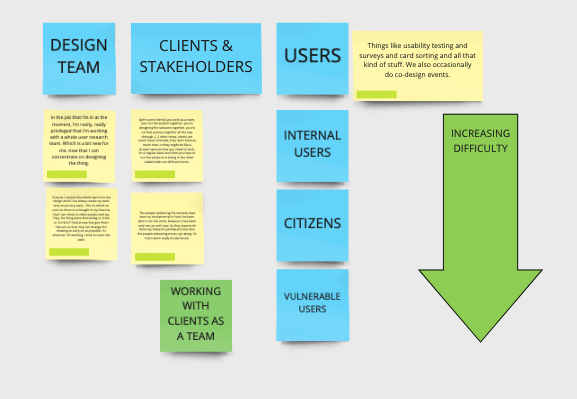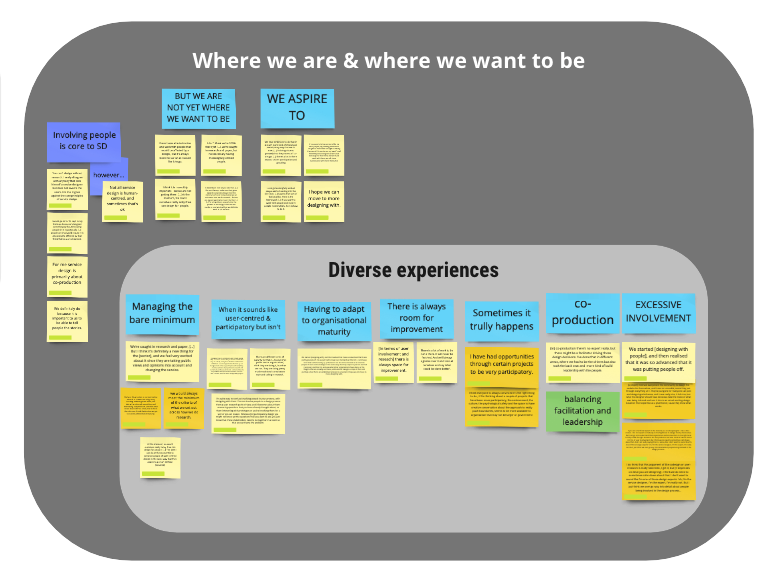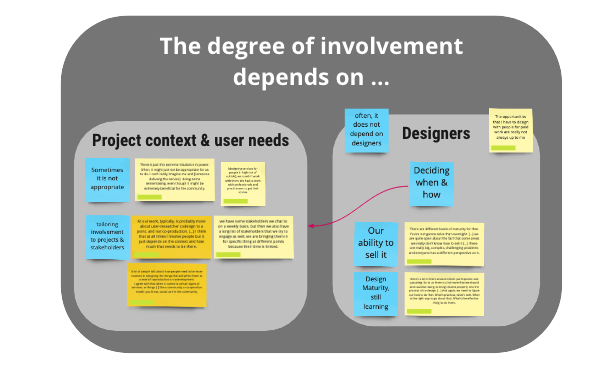Clusters of insights - quick access
Designer work with ...

Access the part of the Miro Board represented in the image
‘Work with’ could be: the internal users, the citizens or vunerable users (in order of increasing the difficulty)
It was also understood as working with your own organisation or working with your client as a team.
List of clusters of insights
Select one of the clusters of insights to see the quotes supporting it. Select it again to hide the quotes.
Users
- Things like usability testing and surveys and card sorting and all that kind of stuff. We also occasionally do co-design events
Design team
- In the job that I‘m in at the moment, I‘m really, really privileged that I‘m working with a whole user research team. Which is a bit new for me. now that I can concentrate on designing the thing.
- How do I involve the whole team into the design work? I‘ve always made my work very visual very early. I like to sketch as soon as there is a thought in my head so that I can show to other people and say “hey, the thing we‘re discussing, is it this or is it this?” And almost like give them the pen so that they can change the drawing as early on as possible. So wherever I‘m working I tend to cover the walls
Client and stakeholders
- [with some clients] you work as a team, you run the session together, you're designing the sessions together, you're on that journey together all the way through. [...] other times, clients are much more removed, they don't have as much time, or they might be like a project sponsor that you check in with, on a regular basis and then you have to run the sessions or being in the other stakeholders at different times
- The people delivering the services have been so fundamental to how I've been able to do this work, because it has been only me up until now. So they have both been my research participants but also the people educating me as I go along. So that’s been really fundamental
Where we are and where we want to be

Access the part of the Miro Board represented in the image
Involving people is code to SD but we are not yet where we want to be - what we aspire to
List of clusters of insights
Select one of the clusters of insights to see the quotes supporting it. Select it again to hide the quotes.
Involving people is core to SD ...
- You can’t design without research. I really disagree with anybody that calls himself a service designer but does not involve the users. For me, it goes against the core principles of service design
- I would go as far to say I rarely think we have ever designed something without involving people in it. I can’t really. [...] people are involved because it is also going to affected by that thing that you are designing.
- For me service design is primarily about co-production
- We definitely do because it is important to us to be able to tell people the stories
- Not all service design is human-centred, and sometimes that's ok
... but we are not yet where we want to be ....
- I have been able to involve and work with people that would be affected by a design , but it's always been not as far as I would like it to go
- I don’t think we‘re 100% there yet [...], we‘re caught in research and paper, but not necessary having meaningfully embed people
- I think it is incredibly important. But we are not getting there. [...] At the moment, we count ourselves really lucky if we can design for people
- It depends on how far you take that. [...] We would always make sure that, given capacity, we would always meet the minimum of the criteria of what we set out across how we do research... But we are always wanting to move it further. [...] [...] To bring citizens properly into the process of co-design, I think we are maybe at a certain level, but we definitely want to get up here
...what we aspire to
- We have ambitions to do that in a much more kind of strong and participatory way that we do now. [...] To bring citizens properly into the process of co-design. [...] there’s a lot in there around citizen participation and upscaling.
- if you were to bring someone like me into a project, my starting point would always be: "how close can I get to having the user of this service on my team?" and then they would be given a fair value exchange for their time, we will share credit with them, we will share maintenance with them there after
- Having meaningfully embed people.We‘re heading into this direction. [...] I guess that sort of thinking like, 'Here is the framework [...] If you want to work with people and involve people meaningfully, here is how to do it
- I hope we can move to more designing with
Diverse experiences
List of clusters of insights
Select one of the clusters of insights to see the quotes supporting it. Select it again to hide the quotes.
Managing the bare minimum
- We‘re caught in research and paper, [...] But I think it‘s definitely a new thing for the [sector], and we feel very excited about it since they are taking public views and opinions into account and changing the service
- We have this ambition to not just inviting a bunch of citizens into a big, scary building, and siting them down, and taking them through something, and then taking away the stuff, and then what do we do with it? You know, that to me is the minimum. I think that’s where we got to in terms of the level of maturity
- We would always meet the minimum of the criteria of what we set out across how we do research
- At the moment, we count ourselves really lucky if we can design for people. [...] The best I can do at the moment is to convince people of user-centred design in the same way that they aspire to person-centred [services]
When it sounds like user-centred & participatory but isn't
- People say they are participatory and include people. They are human-centred. But you start to scratch what they are actually asking me to do that's not the case at all. So there is a lot of opportunities that end up not being available to be very participative with everything - from the definition of project brief, to research and recruitment, all the way to the end - and sometimes it's only revealed after you come at the door. You think "wait a minute, that's not what I thought was going on"
- There are different levels of maturity for that. [...] sometimes [public sector organisations] think they are doing it, but they are not. They are doing pretty much traditional consultation style and calling it research
- It's quite easy to confuse involving people in your process, with designing with them. You can involve people in a design process from a user research point of view, and it becomes about them answering questions that you have already thought about, or them interacting with prototypes or you're involving them for a sort of pre-set reason. Whereas [in] participatory design you might not know yet the questions that you want to ask, you just know that these stakeholders need to be together in a room so that we can frame the problem
Having to adapt to organisational maturity
- We started [designing with], and then realised that it was so advanced that it was putting people off. So we just had to lower our standards a little bit [...] and leave it for later unfortunately. [...] The best I can do at the moment is to convince people of user-centred design in the same way that they aspire to person-centred [services], and then try and use what other organisations have done, or the insights that are already out there, and build our designs on top of that. And perhaps once that is an established process to an extent, I hope we can move to more designing with
There is always room for improvement
- [In terms of user involvement and reseach] there is always space for improvement
- There is a lot of work to be done there. It will never be finished. And we’ll always agonise over it and look at ourselves and say ‘what could be done better'
Sometimes it truly happens
- I have had opportunities through certain projects to be very participatory
- I think everyone is always convinced it's the right thing to do , if I'm thinking about a couple of projects that have been more participatory, the environment, the culture, the psychological safety and the space to have creative conversation about the approach to really push boundaries, seems to be more available to organisation that may not be larger or government
co-production
- [In] co-production there’s no expert really, but there might be a facilitator driving those design decisions. I’ve done that in different areas, where we had to be the drivers but also took the back seat and more kind of build leadership with the people
Excessive involvement
- We started [designing with people], and then realised that it was so advanced that it was putting people off
- [A project] involved everyone in the community to design this website for themselves, and it was so unusable, cause they just through everything at it. They’ve just gone for ‘everyone can post and designing wireframes, and it was really nice, it felt nice, but what the designer should have done was take the inside of what was being inferred and turn it into to an actual working design based on their expertise as a practitioner, cause they know what works
- If you are a technical expert in the materia lyou are designing for - like a data model - I do not expect somebody on the high street to design that by themselves. But I can go and understand their experiences and involve them to the right level to help make the right decisions for that product or service. I kind of have a matrix for this of user involvement. But I think we do need to sometimes calm down about that. And I am really saying this in a sense, like I don’t want to sound like I’m one of those design experts: ‘oh, I’m the service designer, I’m the expert, I’m really not. But I just think we over go way into detail about people being involved in the design process...
- I do think that this argument of like codesign or user-research is really tokenistic, I get it, but [it depends on what you are designing]. I think we do need to sometimes calm down about that. I don’t want to sound like I’m one of those design experts: ‘oh, I’m the service designer, I’m the expert, I’m really not. But I just think we over go way into detail about people being involved in the design process...
The degree of involvment depends on ...

Access the part of the Miro Board represented in the image
Project context and user needs
List of clusters of insights
Select one of the clusters of insights to see the quotes supporting it. Select it again to hide the quotes.
Sometimes it is not appropriate
- There is just this extreme unbalance in power. Often, it might just not be appropriate for us to do. I can’t really imagine me and [someone delivering the service] doing some sensemaking, even though it might be extremely beneficial for the community
- [designing services for people in high risk of suicide], we couldn’t work with them. We had to work with professionals and practitioners to get their stories
Tailoring involvement to projects and stakeholders
- At our work, typically, is probably more about user-researcher codesign to a point, and not co-production, [...] I think that at all times I involve people but it just depends on the context and how much that needs to be there
- we have some stakeholders we chat to on a weekly basis, but then we also have a long list of stakeholders that we try to engage as well, we are bringing them in for specific thing at different points because their time is limited
- A lot of people talk about how people need to be more involved in designing the things that will affect them to a level of coproduction or codevelopment. I agree with that when it comes to certain types of services, or things [..] like a community or cooperative model, you know, social care in the community
Designers
List of clusters of insights
Select one of the clusters of insights to see the quotes supporting it. Select it again to hide the quotes.
Often, it does not depend on designers
- The opportunities that I have to design with people for paid work are really not always up to me
Our ability to sell it
- There are different levels of maturity for that. You’re not gonna solve that overnight. [...] we are quite open about the fact that some areas we really don’t know how to sell it [...] these are really big, complex, challenging problems and everyone has a different perspective on it
Design Maturity, still learning
- there’s a lot in there around citizen participation and upscaling. So to us there is a lot more that we should and could be doing to bring citizens properly into the process of co-design. [...] And again, we need to figure out how to do that. What’s practical, what’s safe. What is the right way to go about that. What’s the effective thing to do there